Enterprise Electronics RANGERX5 Ranger-X5 RADAR User Manual Section 2 Troubleshooting Maintenance Calibration v1 4 DRAFT 002
Enterprise Electronics Corporation Ranger-X5 RADAR Section 2 Troubleshooting Maintenance Calibration v1 4 DRAFT 002
Contents
- 1. User Manual Troubleshooting Maintenance Calibration Part 1
- 2. User Manual Troubleshooting Maintenance Calibration Part 2
- 3. User Manual Overview Theory Part 2
- 4. User Manual Overview Theory Part 1
- 5. User Manual Overview Theory Part 3
- 6. User Manual Overview Theory Part 4
User Manual Troubleshooting Maintenance Calibration Part 1

®
Enterprise Electronics Corporation
T
ECHNICAL
D
OCUMENTATION
S
ET
O
PERATIONS AND
T
ECHNICAL
M
ANUAL
RANGER
®
X5
T
ROUBLESHOOTING
,
M
AINTENANCE
,
AND
C
ALIBRATION
DESIGNED AND MANUFACTURED FOR:
MOBILE
CONFIGURATIONS
SECTION 2
J
OB
9819
EEC • 128 SOUTH INDUSTRIAL BOULEVARD • ENTERPRISE, ALABAMA 36330
TELEPHONE (334) 347-3478 • FAX (334) 393-4556 • www.eecradar.com

Official Enterprise Electronics Corporation (EEC
) Indemnification Clause
The technical data and information (hereinafter “technical data”) contained herein is highly confidential and proprietary in nature and is the sole
and exclusive intellectual property of the Enterprise Electronics Corporation ("EEC"). Any company, organization, entity or individual who seeks
to benefit from the use of this technical data (“User”) agrees to hold said information in strict confidence. User agrees that, unless required by
law, it shall not disclose or make the technical data available in any form to a third party without the specific express written consent of EEC with
regard to each such third party. User agrees to take all necessary steps to ensure that Intellectual Property is not disclosed or distributed by its
Directors, Officers, employees, representatives or agents in violation of this condition.
The User of the technical data contained herein agrees to defend (using counsel of EEC’s choosing), indemnify and hold harmless EEC, its
Directors, Officers and its employees, parent company, affiliate companies and/or subsidiaries, its successors and assigns, customers and users
of its Product(s) against all suits at law or in equity and from damages, claims and demands arising out of the death or injury to any person or
damage of any kind to User's Directors, Officers, employees, agents or property as a result of User's use, misuse, assumptions or interpretations
of the technical data contained herein.
EEC has made its best effort to offer the most current, correct, and clearly expressed information possible. Nevertheless, inadvertent errors in
information may occur. In particular, but without limitation to the above, EEC disclaims any responsibility for typographical errors or punctuation
errors contained herein.
EEC
®
is a registered Trademark of EEC.
EEC PROTECTING PEOPLE AND ASSETS
is a registered Trademark of EEC
RANGER
is a registered Trademark of EEC
TELESPACE
®
is a registered Trademark of EEC
EDGE is a Trademark of EEC.
Encoded Transmitted Signal In A Simultaneous Dual Polarization Weather System
United States Patent
US 7,439,899
Phase Shifted Transmitted Signals In A Simultaneous dual Polarization Weather System
United States Patent
US 7,551,123
Simultaneous Dual Polarization Radar System with Optical Communications Link
United States Patent
US 7,760,129
Simultaneous dual polarization radar systems offered by EEC are covered by one or more of the follow patents:
United States Patents
US 6,859,163 B2 (Inv-1)
US 6,803,875 B1 (Inv-2)
US 7,049,997 (Inv-3)
Foreign Patents
1200500266/13041 (OAPI African Organization) (Inv-1)
200501316/009250 (EA Eurasia) (Inv-1)
13694 (OAPI African Organization) (Inv-3)
2394254 (Russia) (Inv-3)
Simultaneous Dual Polarization Radar System Inv-2
Patented under European patent number 1608997
Various additional domestic and international patents have been applied for.
Validity Date: 24 September 2015
FCC Part 15.19 Warning Statement- (Required for all Part 15 devices)
THIS DEVICE COMPLIES WITH PART 15 OF THE FCC RULES. OPERATION IS SUBJECT TO THE FOLLOWING
TWO CONDITIONS: (1) THIS DEVICE MAY NOT CAUSE HARMFUL INTERFERENCE, AND (2) THIS DEVICE
MUST ACCEPT ANY INTERFERENCE RECEIVED, INCLUDING INTERFERENCE THAT MAY CAUSE
UNDESIRED OPERATION.
FCC Part 15.21 Warning Statement
NOTE: THE GRANTEE IS NOT RESPONSIBLE FOR ANY CHANGES OR MODIFICATIONS NOT EXPRESSLY
APPROVED BY THE PARTY RESPONSIBLE FOR COMPLIANCE. SUCH MODIFICATIONS COULD VOID THE
USER’S AUTHORITY TO OPERATE THE EQUIPMENT.
FCC Part 15.105(b) Warning Statement- (ONLY Required for 15.109-JBP devices)
NOTE: This equipment has been tested and found to comply with the limits for a Class B digital device, pursuant to
part 15 of the FCC Rules. These limits are designed to provide reasonable protection against harmful interference in
a residential installation. This equipment generates uses and can radiate radio frequency energy and, if not installed
and used in accordance with the instructions, may cause harmful interference to radio communications. However,
there is no guarantee that interference will not occur in a particular installation. If this equipment does cause harmful
interference to radio or television reception, which can be determined by turning the equipment off and on, the user
is encouraged to try to correct the interference by one or more of the following measures:
• Reorient or relocate the receiving antenna.
• Increase the separation between the equipment and receiver.
• Connect the equipment into an outlet on a circuit different from that to which the receiver is connected.
• Consult the manufacturer or an experienced radio/TV technician for help.
FCC Part 2.1091 Radiation Safety Warning
NOTE: This equipment complies with the FCC RF radiation exposure limits set forth for an uncontrolled
environment. This equipment should be installed and operated with a minimum distance of 22.43m between the
radiator and any part of your body.
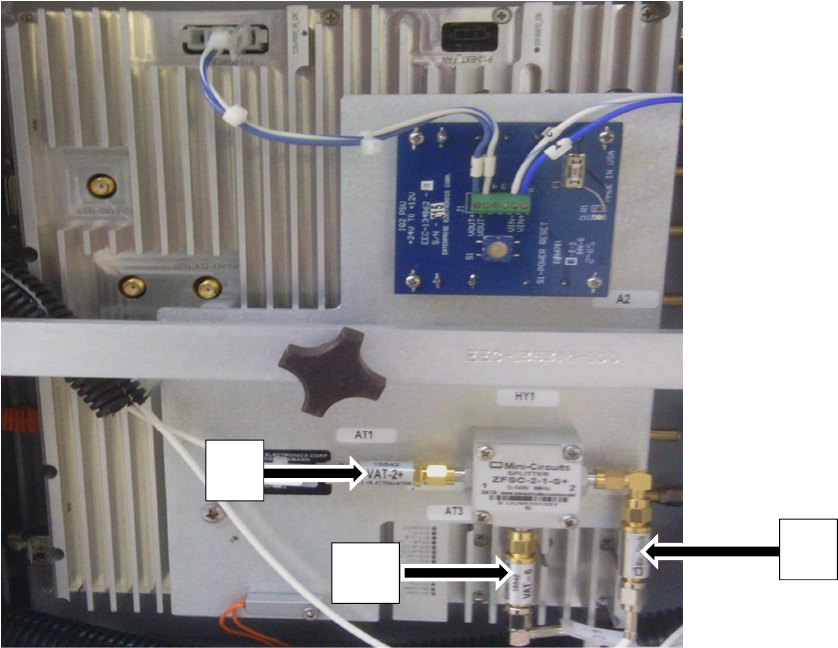
RANGER X5 TUNING PROCEDURE
The power amplitude of the amplifier is completely dependent on the level of RF drive supplied
to the amplifier. The RF drive is dependent on several factors. Drive amplitude is affected by
the local oscillator output (which is adjustable in increments of 0.5 dBm), the 60 MHz IF output
amplitude which derives from the output of the IFD, and the frequency to a lesser degree due to
loss in the cabling.
The system will have a minimum output of 500 Watts (56.989 dBm), with an allowable overage
of 0.792 dBm (Total Overage 600Watts (57.781dBm)). The maximum RF drive into the
amplifier is +14 dBm, however the gain of two amps will not always yield the same output. Due
to some minor inconsistencies in the gain and losses of the amplifiers, each amplifier may have
its RF input drive increased or decreased. In other words, we have the ability to manipulate the
RF drive to each amp independently from one another.
During factory testing the gain is set to around 10 dBm roughly to use as a starting point. The
output of the amplifier is measured using a calibrated peak power meter (sensor) during this
time. The RF drive is then adjusted through the use of SMA attenuators on the 60 MHz IF
signal used in the up-convert chain for Input, Horizontal, and Vertical Channels. The local
oscillator amplitude can be changed if necessary, however this will affect the drive to both
amplifiers therefore, the local oscillator is set to a standard amplitude (typically 9 dBm), and
drive adjustments are made by increasing or decreasing the 60 MHz amplitude as necessary to
achieve the desired output power from the transmitters (Horizontal / Vertical).
SMA attenuators on the 60 MHz IF signal used in the up-convert chain for Input (3.), Horizontal (1.), and
Vertical (2.) Channels.
1.
2
.
3
.

DATE: 22 MARCH 2017 | VERSION: 1.4
I
RANGER-X5 RADAR SYSTEM
T
ROUBLESHOOTING
,
M
AINTENANCE
,
AND
C
ALIBRATION
EEC
®
|
C
OMPANY
P
ROPRIETARY
Revision Information
REVISION DATE MODIFICATION
1.0 15 November 2014 Initial Release
1.1 3 February 2015 Updated with latest procedures per ECNs
1.2 14 February 2017 Updated with latest procedures per ECNs
1.3 15 March 2017 Updated FCC radiation warning and tuning procedures
1.4 22 March 2017 Updated tuning procedures

DATE: 22 MARCH 2017 | VERSION: 1.4
II
RANGER-X5 RADAR SYSTEM
T
ROUBLESHOOTING
,
M
AINTENANCE
,
AND
C
ALIBRATION
EEC
®
|
C
OMPANY
P
ROPRIETARY
TABLE OF CONTENTS
1.
Control Cabinet – Outdoor (Unit 1) ....................................................................................................... 9
1.1.
RCU with Serial Card (Unit 1 A1) .......................................................................................................... 9
1.1.1.
Computer System (Unit 1 A1 A1) .......................................................................................................... 9
1.1.2.
Synclink GT 4E 4-Port Adapter (Unit 1 A1 A2) ................................................................................. 9
1.2.
IQ2 Digital Signal Processor (Unit 1 A2)........................................................................................... 10
1.2.1.
IQ2 Host Computer (Unit 1 A2 A1) ..................................................................................................... 10
1.2.2.
IQ2 DSP PCIe Board (Unit 1 A2 A2) .................................................................................................. 12
1.2.3.
IQ2 Connector Panel (Unit 1 A2 A3) .................................................................................................. 12
1.3.
Keyboard Video Monitor (Unit 1 A3) .................................................................................................. 12
1.4.
EDGE Workstation (Unit 1 A4)............................................................................................................. 13
1.5.
16-Port Gigabit Ethernet Switch (Unit 1 A5) .................................................................................... 14
1.6.
Power Distribution Unit (Unit 1 A6) ..................................................................................................... 15
1.7.
Fiber-Optic Coupler (Unit 1 A7) ........................................................................................................... 16
1.8.
Fiber Optic Media Converter Assembly (Unit 1 A8) ...................................................................... 16
1.8.1.
7-Port Ethernet Switch with 1-Fiber Optic Port (Unit 1 A8 A1) .................................................. 16
1.8.2.
24VDC Power Supply (Unit 1 A8 PS1) ............................................................................................. 16
1.9.
UPS, 2000/1800 KVA (Unit 1 A9) ....................................................................................................... 18
1.10.
E-Stop Panel (Unit 1 A12) ..................................................................................................................... 18
1.11.
DC Power Distribution Plate (Unit 1 A13)......................................................................................... 19
1.11.1.
Lightning Protection Module (Unit 1 A13 A1) .................................................................................. 20
1.11.2.
Contactor, 3-Phase, 24VDC (Unit 1 A13 K1) .................................................................................. 20
1.11.3.
Safety Relay (Unit 1 A13 K2) ............................................................................................................... 21
1.11.4.
24VDC Power Supply (Unit 1 A13 PS1) ........................................................................................... 21
1.11.5.
48VDC Power Supply (Unit 1 A13, PS2) .......................................................................................... 22
1.11.6.
24VDC Power Supply, 600W, 27A Peak (Unit 1 A13 PS3) ........................................................ 22
1.11.7.
12VDC Power Supply (Unit 1 A13 PS4) ........................................................................................... 23
1.12.
I/O Panel Assembly (Unit 1 A14) ........................................................................................................ 24
1.13.
Control Cabinet Modification (Unit 1 MP1) ....................................................................................... 24
2.
Antenna / Pedestal (Unit 2) ................................................................................................................... 27
2.1.
Pedestal Assembly (Unit 2 A1) ............................................................................................................ 27
2.1.1.
Azimuth Assembly (Unit 2 A1 A1) ....................................................................................................... 27
2.1.1.1.
Slip Ring with Fiber Optic Rotary Joint (Unit 2 A1 A1 A1) .......................................................... 27
2.1.1.2.
Actuator Unit (Unit 2 A1 A1 A2) ........................................................................................................... 27
2.1.2.
Elevation Assembly (Unit 2 A1 A2) .................................................................................................... 27
2.1.2.1.
Elevation Endcap Assembly (Unit 2 A1 A2 A1) .............................................................................. 27
2.1.2.1.1.
Actuator Unit .............................................................................................................................................. 28
2.1.2.2.
Elevation Driven Side Unit (Unit 2 A1 A2 A2) ................................................................................. 28
2.1.2.3.
Servo Amplifier, 100V, 10A (Unit 2 A1 A2 A3) ............................................................................... 28
2.1.2.4.
Aquarian Servo Controller PCA (Unit 2 A1 A2 A4) ....................................................................... 30
2.1.2.5.
Regeneration Clamp (Unit 2 A1 A2 A5) ............................................................................................ 31
2.1.3.
Payload Support Assembly (Unit 2 A1 A3) ...................................................................................... 33
2.1.3.1.
Plenum Assembly (Unit 2 A1 A3 A1) ................................................................................................. 33
2.1.3.1.1.
IQ2 Intermediate Frequency Digitizer Assembly (Unit 2 A1 A3 A1 A1) .................................. 33
2.1.3.1.2.
I/O Control Module (Unit 2 A1 A3 A1 A3) ......................................................................................... 36
2.1.3.1.3.
Cold Plate, Weatherized (Unit 2 A1 A3 A1 A4) .............................................................................. 40
2.1.3.1.4.
8-Port Ethernet Switch (Unit 2 A1 A3 A1 A5) .................................................................................. 42
2.1.3.1.5.
Peltier Device Temperature Controller (Unit 2 A1 A3 A1 A6, A7) ............................................ 43
2.1.3.2.
Transceiver Assembly (Horizontal) (Unit 2 A1 A3 A2) ................................................................. 44
2.1.3.2.1.
500W Power Amplifier (Unit 2 A1 A3 A2 A1) .................................................................................. 45
2.1.3.2.2.
Horizontal UDC / Transmitter Control (Unit 2 A1 A3 A2 A2) ...................................................... 45
2.1.3.2.3.
Transceiver Power Supply Unit (Unit 2 A1 A3 A2 A3) ................................................................. 49
2.1.3.2.4.
Temperature / Humidity Sensor (Unit 2 A1 A3 A2 A4) ................................................................. 50
2.1.3.2.5.
Crossguide Coupler (Unit 2 A1 A3 A2 DC1) ................................................................................... 51
2.1.3.2.6.
3-Port Circulator (Unit 2 A1 A3 A2 HY1)........................................................................................... 51
2.1.3.2.7.
TR Limiter (Unit 2 A1 A3 A2 V1) ......................................................................................................... 52
2.1.3.3.
Transceiver Assembly (Vertical) (Unit 2 A1 A3 A3) ...................................................................... 52
2.1.3.3.1.
500W Power Amplifier (Unit 2 A1 A3 A3 A1) .................................................................................. 52
2.1.3.3.2.
Vertical UDC / Transmitter Control (Unit 2 A1 A3 A3 A2) ........................................................... 53
2.1.3.3.3.
Transceiver Power Supply Unit (Unit 2 A1 A3 A3 A3) ................................................................. 53

DATE: 22 MARCH 2017 | VERSION: 1.4
III
RANGER-X5 RADAR SYSTEM
T
ROUBLESHOOTING
,
M
AINTENANCE
,
AND
C
ALIBRATION
EEC
®
|
C
OMPANY
P
ROPRIETARY
2.1.3.3.4.
Temperature / Humidity Sensor (Unit 2 A1 A3 A3 A4) ................................................................. 53
2.1.3.3.5.
Crossguide Coupler (Unit 2 A1 A3 A3 DC1) ................................................................................... 53
2.1.3.3.6.
3-Port Circulator (Unit 2 A1 A3 A3 HY1)........................................................................................... 53
2.1.3.3.7.
TR Limiter (Unit 2 A1 A3 A3 V1) ......................................................................................................... 54
2.1.3.4.
Fluid Pump Assembly (Unit 2 A1 A3 A4) .......................................................................................... 54
2.1.3.5.
Weatherized Liquid Cooler (Unit 2 A1 A4 A6)................................................................................. 54
2.1.4.
V-Clamp Pedestal Assembly (Unit 2 A1 A4) ................................................................................... 54
2.1.5.
Pedestal Enclosure Plate Assembly (Unit 2 A1 A5)...................................................................... 55
2.1.5.1.
7-Port Ethernet Switch with 1-Fiber Optic Port (Unit 2 A1 A5 A1) ........................................... 55
2.1.5.2.
Servo Amplifier, 100V, 10A (Unit 2 A1 A5 A2) ............................................................................... 55
2.1.5.3.
Fiber Optic Coupler (Unit 2 A1 A5 A3) .............................................................................................. 57
2.1.5.4.
Aquarian Servo Controller PCA (Unit 2 A1 A5 A4) ....................................................................... 57
2.1.5.5.
Regeneration Clamp (Unit 2 A1 A5 A5) ............................................................................................ 59
3.
Radome (Unit 3) ....................................................................................................................................... 63
4.
System Troubleshooting ........................................................................................................................ 67
4.1.
Control Cabinet ......................................................................................................................................... 67
4.1.1.
Power ........................................................................................................................................................... 67
4.2.
Pedestal System ....................................................................................................................................... 67
4.2.1.
Azimuth Rotation ...................................................................................................................................... 67
4.2.2.
Elevation Rotation .................................................................................................................................... 67
4.3.
Communication ......................................................................................................................................... 68
4.3.1.
Network Communication ........................................................................................................................ 68
4.3.2.
Control Cabinet to/from Pedestal ........................................................................................................ 68
5.
System Level Calibrations ..................................................................................................................... 71
5.1.1.
Peak Power / Pulse Width and PRF Range Measurement ........................................................ 71
5.1.2.
Transmission / Reception Mode (Horizontal and Vertical) Verification Procedure ............. 74
5.1.3.
Operating Range and Range Resolution Verification Procedure ............................................. 74
5.1.4.
Unambiguous Velocity and Dual PRF Mode Verification Procedure....................................... 75
5.1.5.
Data Output Verification Procedure.................................................................................................... 75
5.2.
Transmitter Verification Procedures ................................................................................................... 76
5.2.1.
Transmitter Control and Indicator Test .............................................................................................. 76
5.2.2.
Transmitter Control Panel Switches and Indicators Test ............................................................ 76
5.2.3.
IQ2 Signal Processor Status Tests .................................................................................................... 77
5.3.
Antenna / Pedestal Tests....................................................................................................................... 80
5.3.1.
Elevation Level Verification Test ......................................................................................................... 80
5.3.2.
Electrical Limit Switch Test ................................................................................................................... 80
5.3.3.
Antenna Speed and Pointing Accuracy Test ................................................................................... 81
5.3.4.
System Interlock and Safe Switch Test ............................................................................................ 81
5.3.4.1.
Azimuth Safe Switch Verification Test ............................................................................................... 81
5.3.4.2.
Elevation Safe Switch Verification Test ............................................................................................ 82
5.3.5.
Azimuth Orientation and Sun-Track Verification ............................................................................ 82
5.4.
Receiver Performance Verification Test ........................................................................................... 83
5.4.1.
IQ2 Receiver Noise Level Verification ............................................................................................... 83
5.4.2.
IQ2 Receiver Calibration and Dynamic Range Verification ........................................................ 83
5.4.3.
Minimum Discernable Signal (MDS) Measurement and Verification Test ............................. 85
5.4.4.
Clutter Filter and Clutter Rejection Verification Test ..................................................................... 85

DATE: 22 MARCH 2017 | VERSION: 1.4
IV
RANGER-X5 RADAR SYSTEM
T
ROUBLESHOOTING
,
M
AINTENANCE
,
AND
C
ALIBRATION
EEC
®
|
C
OMPANY
P
ROPRIETARY
TABLE OF FIGURES
Figure 1. Outdoor Control Cabinet ....................................................................................................................................... 3
Figure 2. 1.8 Meter Ranger-X5 Variant .............................................................................................................................. 4
Figure 3. Signal Processor Status Summary Tab ......................................................................................................... 10
Figure 4. Signal Processor Status DST Voltages Tab ................................................................................................. 11
Figure 5. Signal Processor Status DST Temperature Tab ......................................................................................... 11
Figure 6. KVM Connections ................................................................................................................................................. 12
Figure 7. EDGE Wrokstation ................................................................................................................................................ 14
Figure 8. 24VDC Power Supply .......................................................................................................................................... 18
Figure 9. Servo Amplifier Removal .................................................................................................................................... 29
Figure 10. Regeneration Clamp .......................................................................................................................................... 32
Figure 11. Plenum Assembly – Cover Retaining Screws and Latches .................................................................. 34
Figure 12. Plenum Assembly – IQ2-IFD Retaining Bracket ....................................................................................... 35
Figure 13. Ethernet Switch Retaining Brackets ............................................................................................................. 43
Figure 14. Temperature Controller Retaining Screws ................................................................................................. 44
Figure 15. UDC / Transmitter Control Signal Flow........................................................................................................ 48
Figure 16. Servo Amplifier Removal .................................................................................................................................. 56
Figure 17. Regeneration Clamp .......................................................................................................................................... 59
Figure 18. Test Setup for Peak Power Measurements ............................................................................................... 72
Figure 19 UST Temperature Tab ....................................................................................................................................... 77
Figure 20 UST Voltages Tab................................................................................................................................................ 78
Figure 21 DST Temperatures Tab ..................................................................................................................................... 79
Figure 22 DST Voltages Tab................................................................................................................................................ 80
Figure 23. Typical Calibration Test Results Screenshot (LDR > 100dB) .............................................................. 85
TABLE OF TABLES
Table 1. Discrete (Digital) I/O Module ............................................................................................................................... 37
Table 2. Analog I/O Map ........................................................................................................................................................ 39
Table 3. Transceiver and UDC Voltages .......................................................................................................................... 45
Table 4. UDC / TX Control Power Distribution ............................................................................................................... 47
Table 5 Power Sensor Worksheet...................................................................................................................................... 71
Table 6 Typical power Sensor Specifications ................................................................................................................. 71
Table 7 Peak Power Calculation using Duty Cycle Correction ................................................................................. 73
Table 8 Example of Peak Power Calculation.................................................................................................................. 73
Table 9. Peak Power Test Results ..................................................................................................................................... 74
Table 10. Velocity Scale and Nyquist Interval ................................................................................................................ 75
Table 11. Data Output Verification ..................................................................................................................................... 75
Table 12 Transmitter Control Panel Switches and Indicators Reference Table .................................................. 76
Table 13. Receiver Noise Figure and Dynamic Range Test Results ...................................................................... 84

DATE: 22 MARCH 2017 | VERSION: 1.4
V
RANGER-X5 RADAR SYSTEM
T
ROUBLESHOOTING
,
M
AINTENANCE
,
AND
C
ALIBRATION
EEC
®
|
C
OMPANY
P
ROPRIETARY
This page intentionally blank.

T
ECHNICAL
D
OCUMENTATION
P
ROTECTING
P
EOPLE AND
A
SSETS
®
D
ATE
:
22
M
ARCH
2017
|
V
ERSION
:
1.4
1
R
ANGER
-X5
R
ADAR
S
YSTEM
T
ROUBLESHOOTING
,
M
AINTENANCE
,
AND
C
ALIBRATION
EEC
®
|
C
OMPANY
P
ROPRIETARY
I
NTRODUCTION
S
YSTEM
I
NTRODUCTION AND
O
VERVIEW

T
ECHNICAL
D
OCUMENTATION
P
ROTECTING
P
EOPLE AND
A
SSETS
®
D
ATE
:
22
M
ARCH
2017
|
V
ERSION
:
1.4
2
R
ANGER
-X5
R
ADAR
S
YSTEM
T
ROUBLESHOOTING
,
M
AINTENANCE
,
AND
C
ALIBRATION
EEC
®
|
C
OMPANY
P
ROPRIETARY
This page intentionally blank.

T
ECHNICAL
D
OCUMENTATION
P
ROTECTING
P
EOPLE AND
A
SSETS
®
D
ATE
:
22
M
ARCH
2017
|
V
ERSION
:
1.4
3
R
ANGER
-X5
R
ADAR
S
YSTEM
T
ROUBLESHOOTING
,
M
AINTENANCE
,
AND
C
ALIBRATION
EEC
®
|
C
OMPANY
P
ROPRIETARY
The Enterprise Electronics Corporation (EEC) Ranger-X5 radar system is a new generation, X-
band (3 cm), Adaptive Polarization Doppler Weather Surveillance Radar that fills the gap between
high-cost, high-power traditional radar systems and the passive ground-station weather sensors.
The system uses relatively low power solid-state transmitters and pulse compression technology
to attain nearly the same performance capabilities of much more expensive traditional radar
systems. The Ranger-X5 employs Adaptive Dual Polarization (ADP) techniques to allow
Alternating or Simultaneous Dual Polarization capability with total control over the transmission
polarization state using dual independent coherent transmitters.
The entire Ranger-X5 design concept emphasizes precision, stability, reliability, and value using
proven solid-state technology combined with the most advanced motion control system ever
conceived for weather radar. The sealed, lubricated for life, mechanical drive system in the
Ranger-X5 has an MTBF in excess of 180,000 hours without the need for routine maintenance
or lubrication. The motion system provides extremely high torque to weight ratios for outdoor
operation and greater than 40 arc-second position accuracy.
Advanced configurations and networks of systems are available that meet all of the requirements
for special missions, such as aviation or hydrological forecasting applications.
The flexible architecture and system design facilitates automatic remote operations, ensures
minimal maintenance costs, and provides maximum configurability to meet specialized customer
needs. The Ranger-X5 is designed for continuous (24 hours/day), unattended operations at
remote locations, providing the full suite of polarimetric radar data for local single-site operations,
as a member of a network with predefined product contributions or, as the manager of a network
of remote users providing specific radar products to suite the individual user’s needs.
Figure 1. Outdoor Control Cabinet
The Ranger-X5 radar system is a lightweight, high performance system designed for tactical
grade deployments on a wide variety of fixed and mobile platforms. This densely packed system
provides stability, stiffness, position accuracy and raw power directly coupled to the payload.
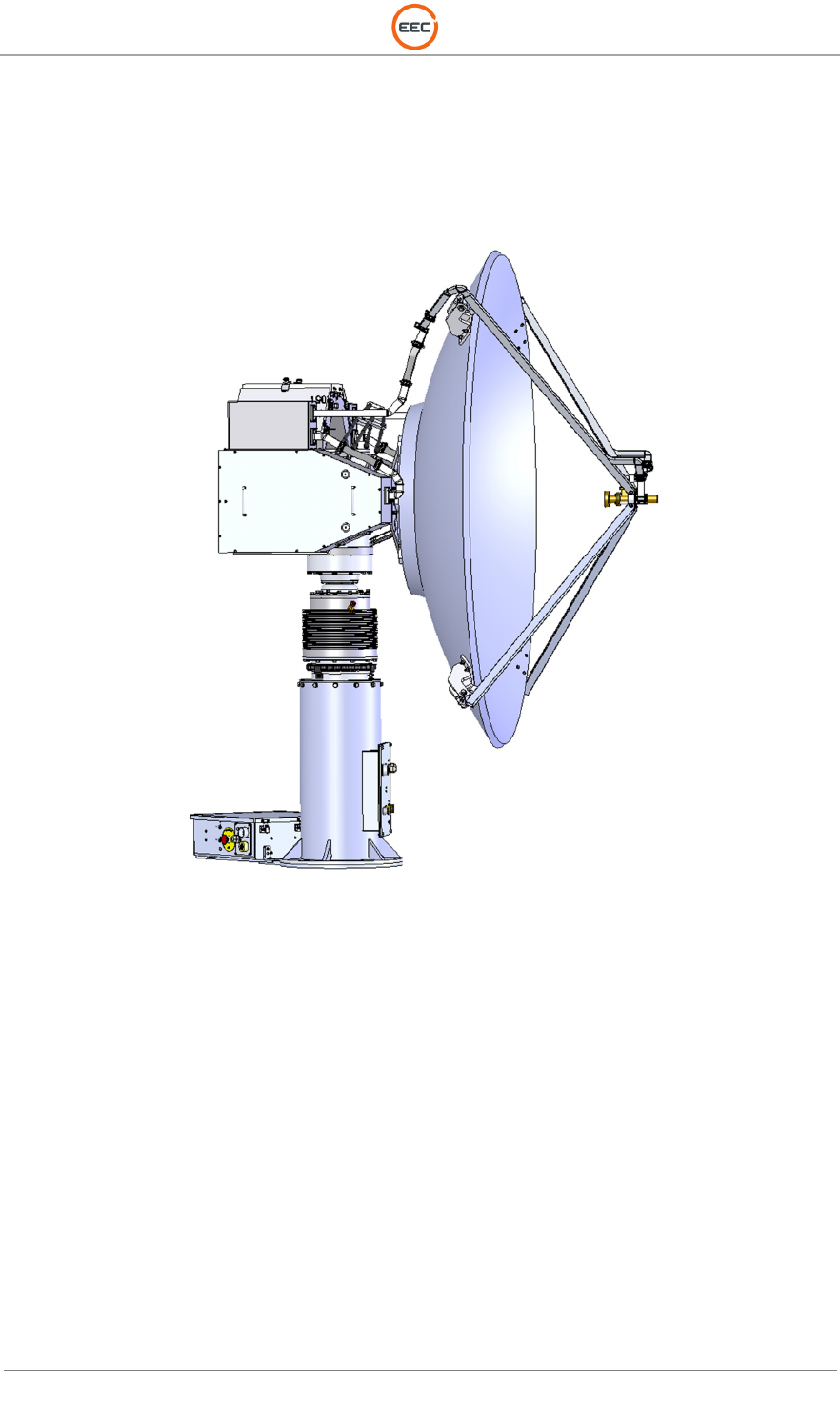
T
ECHNICAL
D
OCUMENTATION
P
ROTECTING
P
EOPLE AND
A
SSETS
®
D
ATE
:
22
M
ARCH
2017
|
V
ERSION
:
1.4
4
R
ANGER
-X5
R
ADAR
S
YSTEM
T
ROUBLESHOOTING
,
M
AINTENANCE
,
AND
C
ALIBRATION
EEC
®
|
C
OMPANY
P
ROPRIETARY
The 1-meter variant shown in FIGURE XX is capable of supporting full operation in sustained
winds up to 75 mph, and with wind gusts to 90 mph. To deliver radar and motor cooling, the
system provides for water-cooling using naval shipboard cooling techniques.
Figure 2. 1.8 Meter Ranger-X5 Variant
The standard Ranger-X5 system configuration includes an elevation over azimuth pedestal
providing on-board, environmentally sealed, and controlled electronics housing for the
transmitters, receivers, and signal digitizer in conjunction with a NEMA 4 grade environmentally
controlled ground interface enclosure. The ground interface contains the system power supplies,
EEC IQ2 signal processor, Local Control Interface (LCI) station, Radar Control Unit (RCU)
Computer running EEC COBRA software, EEC EDGE software system workstation, and
associated communication interfaces. The ground interface enclosure is not required with
customer furnished facilities.
The standard configuration uses two 500-Watt transmitters located on the pedestal above the
elevation rotational axis to support Dual Polarization operation. This design eliminates the need
for waveguide switches, waveguide rotary joints, or a power splitter, allowing for complete
diversity in H/V measurement schemes and minimum path loss in both the transmission and
reception path.
The radar system provides standard precipitation intensity, turbulence, and velocity modes of
analysis with extremely high precision in all modes of operation. Normal radar control and data
processing utilizes the EDGE Radar Control and Analysis Software. A separate technical manual

T
ECHNICAL
D
OCUMENTATION
P
ROTECTING
P
EOPLE AND
A
SSETS
®
D
ATE
:
22
M
ARCH
2017
|
V
ERSION
:
1.4
5
R
ANGER
-X5
R
ADAR
S
YSTEM
T
ROUBLESHOOTING
,
M
AINTENANCE
,
AND
C
ALIBRATION
EEC
®
|
C
OMPANY
P
ROPRIETARY
describes the functions of EDGE.
The transmitter provides a 500W peak RF power pulse (in each channel) with an adjustable pulse
width from 0.2 and 100.0 microseconds (µs), providing excellent weather detection at range in all
modes. The transmitter radiates in staggered Pulse Repetition Frequency (PRF) modes at 3:2,
4:3, or 5:4 ratio allowing dual PRF sampling by the digital signal processor to produce maximum
unambiguous velocities of up to ≥90 meters/second.
The EEC IQ2-IFD Intermediate Frequency Digitizer ingests and digitizes the received radar return
in 16-bit resolution. The receiver design utilizes state-of-the-science components to optimize
detection sensitivity, bandwidth, dynamic range, measurement accuracy, and useful life.
The IQ2-IFD converts the analog receiver IF signals into the digital domain. The IQ2-DSP Digital
Signal Processor receives the digitized Inphase / Quadranture (I/Q) data via the PCI receiver
card. The I/Q data stream is pre-processed and polar rays of meteorological moments are
generated. The ray data is sent via a 1Gbit TCP/IP connection to the IQ2-DSP Signal Processor
for storage and further processing. The IQ2 design optimizes detection sensitivity, bandwidth,
dynamic range, measurement accuracy, and useful life.
The IQ2-DSP is the central data processing point for the radar. The IQ2-DSP is an advanced
scientific computer system utilizing the Linux operating system and employs advanced
scientifically validated algorithms. The standard mode of operation is the proven pulse-pair
method of Doppler processing to produce the standard data moments of Uncorrected Reflectivity
(U), Corrected Reflectivity (ZH), Vertical Reflectivity (ZV), Velocity (V), and Spectrum Width (W).
In addition to the standard base Moments the Ranger-X5 provides the Polarimetric Base
Moments Differential Reflectivity (ZDR), Differential Phase (ΦDP), Specific Differential Phase
(KDP), Correlation Coefficient (ρHV), and Linear Depolarization Ratio (LDR), (where applicable).
The derived moment of rainfall (R) is also included.
General system control utilizes the standard EEC Radar Control Unit (RCU). The RCU is used
to correlate and process BITE information from the various modules and procedures, control the
antenna pedestal operational parameters and perform basic radar control. The RCU integrates
closely with the IQ2 Digital Receiver and IQ2 Digital Signal Processor, communicating by
standard Ethernet Protocol.
The radar system design allows for easy maintenance and has a manually selectable
local/remote mode to permit maintenance personnel to gain local control of the radar system.
Local control is implemented on a Local Control Interface (LCI) Display using a system of menus
and status screens. With the automatic calibration functions and easily accessible system test
points, any necessary system testing, calibration, or repair is easily accomplished with minimum
down time.

T
ECHNICAL
D
OCUMENTATION
P
ROTECTING
P
EOPLE AND
A
SSETS
®
D
ATE
:
22
M
ARCH
2017
|
V
ERSION
:
1.4
6
R
ANGER
-X5
R
ADAR
S
YSTEM
T
ROUBLESHOOTING
,
M
AINTENANCE
,
AND
C
ALIBRATION
EEC
®
|
C
OMPANY
P
ROPRIETARY
This page intentionally blank.

T
ECHNICAL
D
OCUMENTATION
P
ROTECTING
P
EOPLE AND
A
SSETS
®
D
ATE
:
22
M
ARCH
2017
|
V
ERSION
:
1.4
7
R
ANGER
-X5
R
ADAR
S
YSTEM
T
ROUBLESHOOTING
,
M
AINTENANCE
,
AND
C
ALIBRATION
EEC
®
|
C
OMPANY
P
ROPRIETARY
C
HAPTER
1
C
ONTROL
C
ABINET
(U
NIT
1)

T
ECHNICAL
D
OCUMENTATION
P
ROTECTING
P
EOPLE AND
A
SSETS
®
D
ATE
:
22
M
ARCH
2017
|
V
ERSION
:
1.4
8
R
ANGER
-X5
R
ADAR
S
YSTEM
T
ROUBLESHOOTING
,
M
AINTENANCE
,
AND
C
ALIBRATION
EEC
®
|
C
OMPANY
P
ROPRIETARY
This page intentionally blank.

T
ECHNICAL
D
OCUMENTATION
P
ROTECTING
P
EOPLE AND
A
SSETS
®
D
ATE
:
22
M
ARCH
2017
|
V
ERSION
:
1.4
9
R
ANGER
-X5
R
ADAR
S
YSTEM
T
ROUBLESHOOTING
,
M
AINTENANCE
,
AND
C
ALIBRATION
EEC
®
|
C
OMPANY
P
ROPRIETARY
1.
Control Cabinet – Outdoor (Unit 1)
1.1. RCU with Serial Card (Unit 1 A1)
1.1.1. Computer System (Unit 1 A1 A1)
Troubleshooting:
SD-135956-100 Sheet 2 of 3
1. Is the RCU receiving power?
YES: Continue to Step 2.
NO: Check the input power and output power using the Schematics.
2. Is the COBRA Software loading properly?
YES: Continue to Step 3.
NO: Refer to Volume 5, Chapter 2, COBRA Operations.
3. Are the communications with the network working properly?
YES: There is likely a problem with the COBRA Software load, Refer to Volume 2, Section
5, COBRA SW/FW Maintenance.
NO: Refer to paragraphs 1.5, 1.8.1, and 2.1.5.1 to ensure the Ethernet Switches are
operating properly.
Maintenance:
If the RCU system is inoperative OR the COBRA software will not load, replace the RCU.
1. Disconnect all cables from the rear of the RCU.
2. Use the quick disconnect latches to loosen the RCU from the 19-inch rack.
3. Pull the RCU out on the rails.
4. Disconnect the RCU from the rails.
5. Reinstall the RCU in reverse order of steps 1-4.
6. Return the RCU to the manufacturer for troubleshooting and/or repair.
Calibration:
None Required
1.1.2. Synclink GT 4E 4-Port Adapter (Unit 1 A1 A2)
Part of Computer System (Unit 1 A1)

T
ECHNICAL
D
OCUMENTATION
P
ROTECTING
P
EOPLE AND
A
SSETS
®
D
ATE
:
22
M
ARCH
2017
|
V
ERSION
:
1.4
10
R
ANGER
-X5
R
ADAR
S
YSTEM
T
ROUBLESHOOTING
,
M
AINTENANCE
,
AND
C
ALIBRATION
EEC
®
|
C
OMPANY
P
ROPRIETARY
1.2. IQ2 Digital Signal Processor (Unit 1 A2)
1.2.1. IQ2 Host Computer (Unit 1 A2 A1)
Troubleshooting:
SD-135956-100 Sheet 2 of 3
Maintenance:
If the IQ2 Digital Signal Processor is inoperative OR the EDGE software will not load, replace the
entire unit.
1. Disconnect all cables from the rear of the IQ2-DSP.
2. Loosen the screws retaining the IQ2-DSP in the 19-inch rack.
3. Pull the IQ2-DSP out of the 19-inch rack.
4. Reinstall the IQ2-DSP in reverse order of steps 1-3.
5. Return the IQ2-DSP to the manufacturer for troubleshooting and/or repair.
Verification:
This check is to verify the IQ2- Digital Signal Processor (DSP) (displayed as DST on EDGE) and
the IQ2- Intermediate Frequency Digitizer (IFD) (displayed as UST on EDGE) are working within
specified voltage and temperature limits.
1. From EDGE Control screen, open the Signal Processor Status screen.
2. On the Summary tab, verify the IQ2 and UST Uptime status. See Figure 3.
Figure 3. Signal Processor Status Summary Tab
3. On the DST Voltages tab, verify all voltages are within specified limits and the
corresponding indicator is green. See Figure 4.
EEC-GT1345
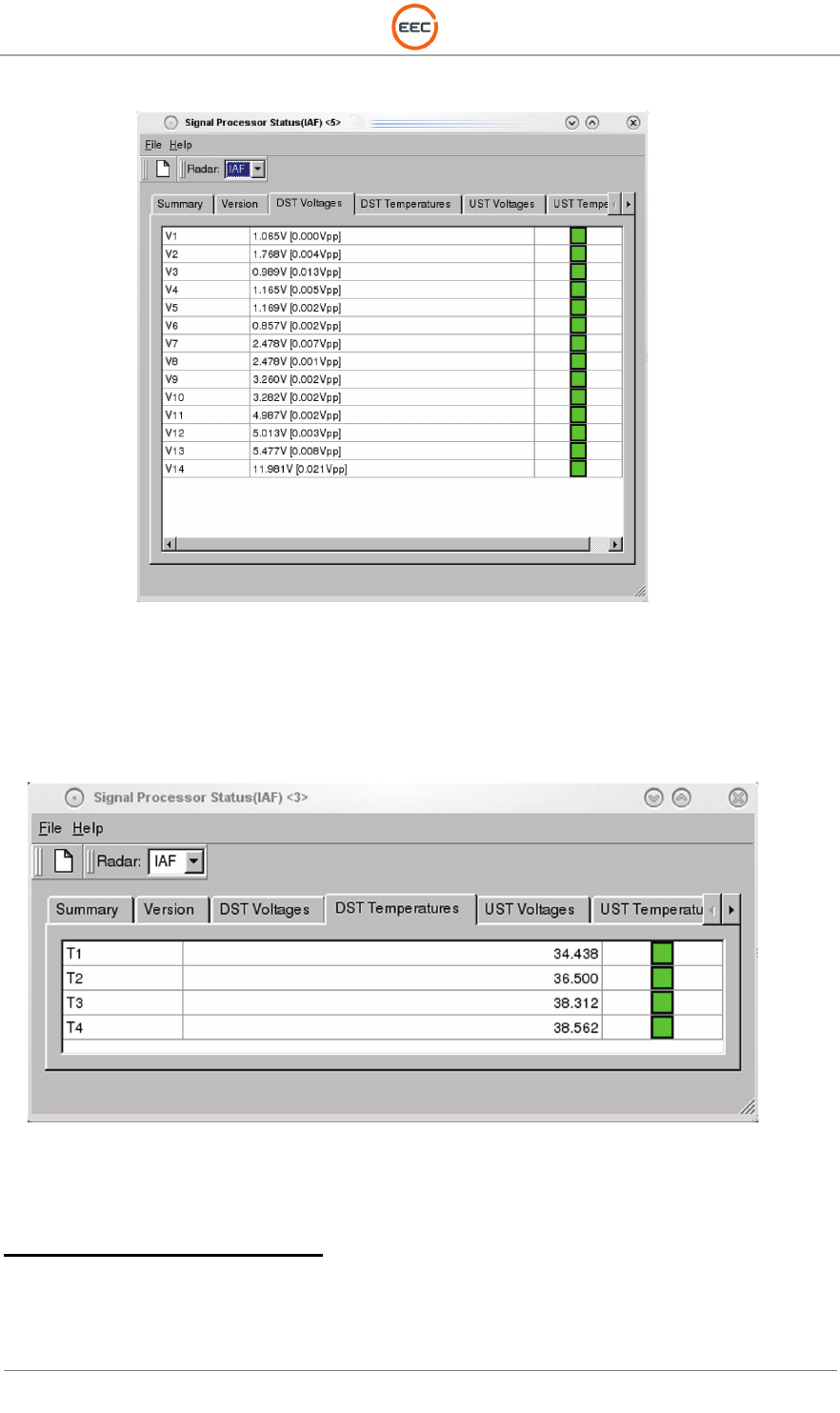
T
ECHNICAL
D
OCUMENTATION
P
ROTECTING
P
EOPLE AND
A
SSETS
®
D
ATE
:
22
M
ARCH
2017
|
V
ERSION
:
1.4
11
R
ANGER
-X5
R
ADAR
S
YSTEM
T
ROUBLESHOOTING
,
M
AINTENANCE
,
AND
C
ALIBRATION
EEC
®
|
C
OMPANY
P
ROPRIETARY
Figure 4. Signal Processor Status DST Voltages Tab
4. On the DST Temperature Tab, verify temperatures for the DST Processor are below 70°
Celsius and LEDs are lit green. See Figure 5.
5.
Figure 5. Signal Processor Status DST Temperature Tab
Calibration and Verification Tests:
See Paragraph 5.2.3.
EEC-GT1346
EEC-GT1347

T
ECHNICAL
D
OCUMENTATION
P
ROTECTING
P
EOPLE AND
A
SSETS
®
D
ATE
:
22
M
ARCH
2017
|
V
ERSION
:
1.4
12
R
ANGER
-X5
R
ADAR
S
YSTEM
T
ROUBLESHOOTING
,
M
AINTENANCE
,
AND
C
ALIBRATION
EEC
®
|
C
OMPANY
P
ROPRIETARY
1.2.2. IQ2 DSP PCIe Board (Unit 1 A2 A2)
Part of IQ2-DSP (Unit 1 A2)
1.2.3. IQ2 Connector Panel (Unit 1 A2 A3)
Part of IQ2-DSP (Unit 1 A2)
1.3. Keyboard Video Monitor (Unit 1 A3)
Troubleshooting:
SD-135956-100 Sheet 2 of 3
1. Is the KVM receiving power?
YES: Continue to Step 2.
NO: Check the input power and output power using the Schematics.
a. Go to the UPS (A9) and measure power at Segment 2, Port 2.
b. If no power is on the UPS, check to ensure the Emergency Stop button on the S-
Stop Panel (A11) is not depressed.
c. If the Emergency Stop button is not depressed, check the position of CB1 on the
E-Stop Panel Assembly.
d. If the Circuit Breaker (CB1) is on, check to ensure there is input Power to the
system.
2. If the KVM is receiving power but not communicating with the RCU or IQ2-Digital Signal
Processor, then there is likely a connection problem.
a. Check the Keyboard and Mouse Connectors on the back of the KVM. See Figure
6, points 5, 6, and 7.
Figure 6. KVM Connections

T
ECHNICAL
D
OCUMENTATION
P
ROTECTING
P
EOPLE AND
A
SSETS
®
D
ATE
:
22
M
ARCH
2017
|
V
ERSION
:
1.4
13
R
ANGER
-X5
R
ADAR
S
YSTEM
T
ROUBLESHOOTING
,
M
AINTENANCE
,
AND
C
ALIBRATION
EEC
®
|
C
OMPANY
P
ROPRIETARY
Maintenance:
If power or communication fail and cannot be restored, replace the unit.
1. Disconnect all cables from the rear of the KVM.
2. Unscrew and remove the screws to loosen the KVM from the 19-inch rack.
3. Pull the KVM out on the rails.
4. Disconnect the KVM from the rails.
5. Reinstall the KVM in reverse order of steps 1-4.
6. Return the KVM to the manufacturer for troubleshooting and/or repair.
Calibration:
None
1.4. EDGE Workstation (Unit 1 A4)
Troubleshooting:
SD-135956-100 Sheet 2 of 3
1. Is the EDGE Workstation receiving power?
YES: Continue to Step 2.
NO: Check the input power and output power using the Schematics.
a. Go to the Power Distribution Unit (A6) and measure power at A1.
b. If no power is on the Power Distribution Unit, check the output power on the UPS,
Segment 1, Wire 2.
c. If no power is on the UPS, check to ensure the Emergency Stop button on the S-
Stop Panel (A11) is not depressed.
d. If the Emergency Stop button is not depressed, check the position of CB1 on the
E-Stop Panel Assembly.
e. If the Circuit Breaker (CB1) is on, check to ensure there is input Power to the
system.
2. If the KVM is receiving power but not communicating with the RCU or IQ2-Digital Signal
Processor, then there is likely a connection problem.
a. Troubleshoot the Fiber Optic Media Converter (See Paragraph 1.8) and the 16-
Port Ethernet Switch (See Paragraph 1.5).

T
ECHNICAL
D
OCUMENTATION
P
ROTECTING
P
EOPLE AND
A
SSETS
®
D
ATE
:
22
M
ARCH
2017
|
V
ERSION
:
1.4
14
R
ANGER
-X5
R
ADAR
S
YSTEM
T
ROUBLESHOOTING
,
M
AINTENANCE
,
AND
C
ALIBRATION
EEC
®
|
C
OMPANY
P
ROPRIETARY
Figure 7. EDGE Wrokstation
Maintenance:
If the EDGE workstation does not perform properly or software will not load properly, replace the
unit.
1. Disconnect all cables from the rear of the EDGE Workstation.
2. Unscrew and remove the screws to loosen the EDGE Workstation from the 19-inch rack.
3. Pull the EDGE Workstation out of the 19-inch Rack.
4. Reinstall the EDGE Workstation in reverse order of steps 1-3.
5. Return the EDGE Workstation to the manufacturer for troubleshooting and/or repair.
Calibration:
None
1.5. 16-Port Gigabit Ethernet Switch (Unit 1 A5)
Troubleshooting:
SD-135956-100 Sheet 2 of 3
1. Is the Ethernet Switch receiving power?
YES: Continue to Step 2.
NO: Check the input power and output power using the Schematics.
a. Go to the UPS, Segment 1 output and measure power on Wire 7.
b. If no power is on the UPS, check to ensure the Emergency Stop button on the S-
Stop Panel (A11) is not depressed.
c. If the Emergency Stop button is not depressed, check the position of CB1 on the
E-Stop Panel Assembly.
d. If the Circuit Breaker (CB1) is on, check to ensure there is input Power to the
system.
2. If the Ethernet Switch is receiving power but not communicating with any of the units,
then there is likely a connection problem. Unplug the unit in question and plug it back
into an unused port. If the problem persists, there is nothing wrong with the Ethernet

T
ECHNICAL
D
OCUMENTATION
P
ROTECTING
P
EOPLE AND
A
SSETS
®
D
ATE
:
22
M
ARCH
2017
|
V
ERSION
:
1.4
15
R
ANGER
-X5
R
ADAR
S
YSTEM
T
ROUBLESHOOTING
,
M
AINTENANCE
,
AND
C
ALIBRATION
EEC
®
|
C
OMPANY
P
ROPRIETARY
Switch. If the problem is corrected, then there is likely a “dead Ethernet port” on the
Ethernet Switch. Replace the Ethernet Switch.
Maintenance:
If the Ethernet Switch does not perform properly, replace the unit.
1. Disconnect all cables from the Ethernet Switch, front and back.
2. Unscrew and remove the screws to loosen Ethernet Switch from the 19-inch rack.
3. Pull the Ethernet Switch out of the 19-inch Rack.
4. Reinstall the Ethernet Switch in reverse order of steps 1-3.
Calibration:
None
1.6. Power Distribution Unit (Unit 1 A6)
Troubleshooting:
SD-135956-100 Sheet 2 of 3
1. Is the Power Distribution Unit receiving power?
YES: Continue to Step 2.
NO: Check the input power and output power using the Schematics.
a. Go to the UPS, Segment 1 output and measure power on Wire 2 and Wire 3.
b. If no power is on the UPS, check to ensure the Emergency Stop button on the S-
Stop Panel (A11) is not depressed.
c. If the Emergency Stop button is not depressed, check the position of CB1 on the
E-Stop Panel Assembly.
d. If the Circuit Breaker (CB1) is on, check to ensure there is input Power to the
system.
2. If the Power Distribution Unit is receiving power input from the UPS, but has no power
output, use the power switch to turn the unit OFF, then ON. Did the unit reset?
YES: End the process.
NO: Replace the Power Distribution Unit.
Maintenance:
If power fails and cannot be restored, replace the unit.
1. Disconnect all cables from the rear of the Power Distribution Unit (PDU).
2. Unscrew and remove the screws to loosen the PDU from the 19-inch rack.
3. Pull the PDU out on the rails.
4. Disconnect the PDU from the rails.
5. Reinstall the PDU in reverse order of steps 1-4.
6. Return the PDUto the manufacturer for troubleshooting and/or repair.
Calibration:
None

T
ECHNICAL
D
OCUMENTATION
P
ROTECTING
P
EOPLE AND
A
SSETS
®
D
ATE
:
22
M
ARCH
2017
|
V
ERSION
:
1.4
16
R
ANGER
-X5
R
ADAR
S
YSTEM
T
ROUBLESHOOTING
,
M
AINTENANCE
,
AND
C
ALIBRATION
EEC
®
|
C
OMPANY
P
ROPRIETARY
1.7. Fiber-Optic Coupler (Unit 1 A7)
Troubleshooting:
SD-133116-100 Sheet 1 of 1
If the Fiber-Optic network isn’t connected, check this unit as a last resort. There are several
spare ports. This is a passive device and it should not fail during the operational life of the radar
system.
Maintenance:
None
Calibration:
None
1.8. Fiber Optic Media Converter Assembly (Unit 1 A8)
1.8.1. 7-Port Ethernet Switch with 1-Fiber Optic Port (Unit 1 A8 A1)
Troubleshooting:
SD-133116-100 Sheet 1 of 1
1. Is the Ethernet Switch receiving power?
YES: Continue to Step 2.
NO: Check the input power using the Schematics.
a. Check the 24VDC Power at the input of the Ethernet.
b. If power is present, proceed to Step 2.
2. If the Ethernet Switch is receiving power but not communicating with any of the units,
then there is likely a connection problem. Replace the Ethernet Switch.
Maintenance:
If the Ethernet Switch does not perform properly, replace the unit.
1. Disconnect all cables from the Ethernet Switch.
2. Use a screwdriver to disconnect from the DIN rail.
3. Pull the Ethernet Switch from the DIN rail.
4. Reinstall the Ethernet Switch in reverse order of steps 1-3.
Calibration:
None
1.8.2. 24VDC Power Supply (Unit 1 A8 PS1)
Troubleshooting:

T
ECHNICAL
D
OCUMENTATION
P
ROTECTING
P
EOPLE AND
A
SSETS
®
D
ATE
:
22
M
ARCH
2017
|
V
ERSION
:
1.4
17
R
ANGER
-X5
R
ADAR
S
YSTEM
T
ROUBLESHOOTING
,
M
AINTENANCE
,
AND
C
ALIBRATION
EEC
®
|
C
OMPANY
P
ROPRIETARY
SD-135956-100 Sheet 2 of 3
SD-133116-100 Sheet 1 of 1
Troubleshooting:
1. Initial Testing:
Using a voltmeter, measure the voltage of PS1 (Unit 1 A8 PS1) to verify proper voltage
output. Check at the output of the power supply. Is it providing 24 VDC?
NO: Verify AC power is present by measuring the input voltage on the input side of the
Power Supply. If AC voltage is present, replace the failed Power Supply.
YES: Go to Step 2.
2. Check the Ethernet Switch:
Is the Ethernet Switch powered on?
NO: Check the fuse (F3) between the power supply and Ethernet switch.
YES: End Step.
Maintenance:
If the Power Supply does not perform properly, replace the unit.
1. Disconnect all cables from the Power Supply.
2. Use a screwdriver to disconnect from the DIN rail.
3. Pull the Power Supply from the DIN rail.
4. Reinstall the Power Supply in reverse order of steps 1-3.
Calibration:
In the event of a total failure of the 24 VDC Power Supply, the Fiber Optic Media Converter will not function
Procedure:
Adjust the 24VDC Power Supplies to 24VDC after replacement. To make the adjustment:
1) Ensure AC Power is available. The “DC ON” LED will illuminate.
2) Connect a Volt Meter to the output of the Power Supply.
3) Measure the voltage.
4) Using the Vout ADJ., adjust the voltage upward (clockwise turns) or downward (counter
clockwise turns) until the voltage readout is 24.0 VDC on the Volt Meter. Note: The
operational range of the voltage is 23.0 VDC to 24.6 VDC.
5) Cleanup the work area and return the Radar System to normal operations.

T
ECHNICAL
D
OCUMENTATION
P
ROTECTING
P
EOPLE AND
A
SSETS
®
D
ATE
:
22
M
ARCH
2017
|
V
ERSION
:
1.4
18
R
ANGER
-X5
R
ADAR
S
YSTEM
T
ROUBLESHOOTING
,
M
AINTENANCE
,
AND
C
ALIBRATION
EEC
®
|
C
OMPANY
P
ROPRIETARY
Figure 8. 24VDC Power Supply
1.9. UPS, 2000/1800 KVA (Unit 1 A9)
Troubleshooting:
SD-135956-100 Sheet 2 of 3
Use Vendor Documentation (See Volume 2, Section 4, Paragraph 1.9)
Maintenance:
Maintain the UPS per the Vendor Documentation.
Calibration:
None
1.10. E-Stop Panel (Unit 1 A12)
Troubleshooting:
SD-135956-100 Sheet 2 of 3
The E-Stop Panel consists of two circuit breakers (CB1 and CB2), three power indicators (Input,
Main, and Pedestal), and E-Stop Button, and an E-Stop Reset Button. Troubleshoot according
to the Schematic. The E-Stop Button and E-Stop Reset Button control the Contactor and Relay
on the DC Power Distribution Plate (See Paragraph 1.11).
Maintenance:
Maintenance will consist of typical electrical maintenance activities.
Calibration:
None

T
ECHNICAL
D
OCUMENTATION
P
ROTECTING
P
EOPLE AND
A
SSETS
®
D
ATE
:
22
M
ARCH
2017
|
V
ERSION
:
1.4
19
R
ANGER
-X5
R
ADAR
S
YSTEM
T
ROUBLESHOOTING
,
M
AINTENANCE
,
AND
C
ALIBRATION
EEC
®
|
C
OMPANY
P
ROPRIETARY
1.11. DC Power Distribution Plate (Unit 1 A13)
The DC Power Distribution Plate control is through the E-Stop Panel (Unit 1 A12). When any
component on the DC Power Distribution Plate is not functioning (with the exception of the
Lightning Protection Module), follow the troubleshooting procedures in this section.
When the operator presses the E-Stop Button, the Safety Relay (K2) removes DC Power from
the Contactor (K1). When the Contactor (K1) is OPEN, AC Power is removed from the main DC
Power Supplies (PS2, PS3, PS4) which provide DC power to the Pedestal (Unit 2). Should the
24VDC Power Supply (PS1) fail, all DC Power will fail.
Troubleshooting:
SD-135956-100 Sheet 2 of 3
SD-134932-101 Sheet 1 of 1
Follow these procedures for any failure on the DC Power Distribution Plate.
1. Step 1:
Is this a communication problem?
YES: Go to Paragraph 1.11.1
NO: Go to Step 2.
2. Step 2:
Troubleshoot the 24VDC Power Supply (PS1) per Paragraph 1.11.4., then proceed to
Step 3.
3. Step 3:
Reset the E-Stop system using the E-Stop Reset Button on the E-Stop Panel. Is the
problem resolved?
NO: Continue to Step 4.
YES: End Process.
4. Step 4:
Troubleshoot the Safety Relay (K2) per Paragraph 1.11.3 and the Contactor (K1) per
Paragraph 1.11.2. Is the problem resolved?
NO: Continue to Step 4.
YES: End Process.
5. Step 5:
Troubleshoot each individual DC Power Supply.
• Troubleshoot the 48VDC Power Supply (PS2) per Paragraph 1.11.5.
• Troubleshoot the 24VDC Power Supply (PS3) per Paragraph 1.11.6.
• Troubleshoot the 12VDC Power Supply (PS4) per Paragraph 1.11.7.
Is the problem resolved?
NO: Contact the Manufacturer.
YES: End Process.

T
ECHNICAL
D
OCUMENTATION
P
ROTECTING
P
EOPLE AND
A
SSETS
®
D
ATE
:
22
M
ARCH
2017
|
V
ERSION
:
1.4
20
R
ANGER
-X5
R
ADAR
S
YSTEM
T
ROUBLESHOOTING
,
M
AINTENANCE
,
AND
C
ALIBRATION
EEC
®
|
C
OMPANY
P
ROPRIETARY
1.11.1. Lightning Protection Module (Unit 1 A13 A1)
Troubleshooting:
SD-135956-100 Sheet 2 of 3
SD-134932-101 Sheet 1 of 1
If the Ranger-X5 has lost communication to the outside WAN, this unit may need to be replaced.
Test this unit by bypassing the connection temporarily.
Maintenance:
To replace the Lightning Protection Module:
1. Unscrew the four screws mounting the system to the DC Power Distribution Plate.
2. Disconnect the ground wires.
3. Disconnect the Ethernet Cables.
4. Reinstall in reverse order of Steps 1-3.
Calibration:
None
1.11.2. Contactor, 3-Phase, 24VDC (Unit 1 A13 K1)
Troubleshooting:
SD-134932-101 Sheet 1 of 1
The Contactor (K1) is controlled through the Safety Relay (K2).
1. Initial Testing:
If DC power is applied to the Contactor, it closes and allows AC power to flow through
the relay to the other three DC power supplies on the DC Power Distribution Plate (Unit
1 A13). If DC power is removed, the switch opens and removes AC power preventing
the operation of the other DC Power Supplies. Control is through the Safety replay.
Insure DC power is available on A1 and A2 of the Contactor. Is it present?
NO: Reset the E-Stop System and check the output DC power from Point 14 on the
Safety Relay (K2). Is DC power present?
YES: Replace the Contactor (K1).
NO: Go to Paragraph 1.11.3
YES: Return to Paragraph 1.11
Maintenance:
To replace the Contactor:

T
ECHNICAL
D
OCUMENTATION
P
ROTECTING
P
EOPLE AND
A
SSETS
®
D
ATE
:
22
M
ARCH
2017
|
V
ERSION
:
1.4
21
R
ANGER
-X5
R
ADAR
S
YSTEM
T
ROUBLESHOOTING
,
M
AINTENANCE
,
AND
C
ALIBRATION
EEC
®
|
C
OMPANY
P
ROPRIETARY
1. Disconnect the terminals / wires from the Contactor.
2. Use a slotted screwdriver to disconnect the Contactor from the DIN rail.
3. Reinstall in reverse order of Steps 1-2.
Calibration:
None
1.11.3. Safety Relay (Unit 1 A13 K2)
Troubleshooting:
SD-134932-101 Sheet 1 of 1
1. Initial Testing:
The Safety Relay receives power from a 24VDC Power Supply (PS1). Is power
present?
NO: Go to Paragraph 1.11.4
YES: Go to Step 2
2. Reset E-Stop
Press the E-Stop Button and then press the E-Stop Reset Button. Is power restored
TO the Contactor (K1). Check the input of the Contractor (K1) at point A1 and A2.
YES: Return to Paragraph 1.11, Troubleshooting, Step 5.
NO: Replace the Safety Relay.
Maintenance:
To replace the Safety Relay:
1. Disconnect the terminals / wires from the Safety Relay.
2. Use a slotted screwdriver to disconnect the Safety Relay from the DIN rail.
3. Reinstall in reverse order of Steps 1-2.
Calibration:
None
1.11.4. 24VDC Power Supply (Unit 1 A13 PS1)
Troubleshooting:
SD-134932-101 Sheet 1 of 1
1. Initial Testing:
Using a voltmeter, measure the voltage of PS1 (Unit 1 13 PS1) to verify proper voltage
output. Check at the output of the power supply. Is it providing 24 VDC?
NO: Verify AC power is present by measuring the input voltage on the TB1-3, 4, & 5 to

T
ECHNICAL
D
OCUMENTATION
P
ROTECTING
P
EOPLE AND
A
SSETS
®
D
ATE
:
22
M
ARCH
2017
|
V
ERSION
:
1.4
22
R
ANGER
-X5
R
ADAR
S
YSTEM
T
ROUBLESHOOTING
,
M
AINTENANCE
,
AND
C
ALIBRATION
EEC
®
|
C
OMPANY
P
ROPRIETARY
ensure the presence of AC Power. If AC voltage is present, replace the failed Power
Supply.
YES: End Process.
Maintenance:
See Paragraph 1.8.2, Maintenance.
Calibration:
See Paragraph 1.8.2, Calibration.
1.11.5. 48VDC Power Supply (Unit 1 A13, PS2)
Troubleshooting:
SD-134932-101 Sheet 1 of 1
1. Step 1:
Using a voltmeter, measure the input AC Voltage on Terminal Block 1, point 6, 7, and 8.
Is AC Voltage Present?
NO: Troubleshoot the input power, then return to this step.
YES: Go to Step 2.
2. Step 2:
Using a voltmeter, measure the input DC Voltage on Terminal Block 2, point 4 and 5. Is
DC Voltage Present?
NO: Replace the Power Supply.
YES: Go to Paragraph 1.11.6
Maintenance:
To replace the Power Supply:
1. Disconnect ALL the terminals / wires from the input and output of the Power Supply.
2. Using a Philips Head screwdriver, loosen the screws connecting the Power Supply to the
Plate.
3. Remove the Power Supply from the Plate.
4. Reinstall in reverse order of Steps 1-3.
Calibration:
None
1.11.6. 24VDC Power Supply, 600W, 27A Peak (Unit 1 A13 PS3)
Troubleshooting:
SD-134932-101 Sheet 1 of 1

T
ECHNICAL
D
OCUMENTATION
P
ROTECTING
P
EOPLE AND
A
SSETS
®
D
ATE
:
22
M
ARCH
2017
|
V
ERSION
:
1.4
23
R
ANGER
-X5
R
ADAR
S
YSTEM
T
ROUBLESHOOTING
,
M
AINTENANCE
,
AND
C
ALIBRATION
EEC
®
|
C
OMPANY
P
ROPRIETARY
1. Step 1:
Using a voltmeter, measure the input AC Voltage on Terminal Block 1, point 9, 10, and
11. Is AC Voltage Present?
NO: Troubleshoot the input power, then return to this step.
YES: Go to Step 2.
2. Step 2:
Using a voltmeter, measure the input DC Voltage on Terminal Block 2, point 6 and 7. Is
DC Voltage Present?
NO: Replace the Power Supply.
YES: Go to Paragraph 1.11.7
Maintenance:
To replace the Power Supply:
1. Disconnect ALL the terminals / wires from the input and output of the Power Supply.
2. Using a Philips Head screwdriver, loosen the screws connecting the Power Supply to the
Plate.
3. Remove the Power Supply from the Plate.
4. Reinstall in reverse order of Steps 1-3.
Calibration:
None
1.11.7. 12VDC Power Supply (Unit 1 A13 PS4)
Troubleshooting:
SD-134932-101 Sheet 1 of 1
1. Step 1:
Using a voltmeter, measure the input AC Voltage on Terminal Block 1, point 9, 10, and
11. Is AC Voltage Present?
NO: Troubleshoot the input power, then return to this step.
YES: Go to Step 2.
2. Step 2:
Using a voltmeter, measure the input DC Voltage on Terminal Block 2, point 8 and 9. Is
DC Voltage Present?
NO: Replace the Power Supply.
YES: Return to Paragraph
Maintenance:

T
ECHNICAL
D
OCUMENTATION
P
ROTECTING
P
EOPLE AND
A
SSETS
®
D
ATE
:
22
M
ARCH
2017
|
V
ERSION
:
1.4
24
R
ANGER
-X5
R
ADAR
S
YSTEM
T
ROUBLESHOOTING
,
M
AINTENANCE
,
AND
C
ALIBRATION
EEC
®
|
C
OMPANY
P
ROPRIETARY
See Paragraph 1.8.2, Maintenance.
Calibration:
None
1.12. I/O Panel Assembly (Unit 1 A14)
Troubleshooting:
SD-134932-101 Sheet 1 of 1
Maintenance:
No Maintenance Required.
Calibration:
None
1.13. Control Cabinet Modification (Unit 1 MP1)
No Troubleshooting, Maintenance or Calibration Required.

T
ECHNICAL
D
OCUMENTATION
P
ROTECTING
P
EOPLE AND
A
SSETS
®
D
ATE
:
22
M
ARCH
2017
|
V
ERSION
:
1.4
25
R
ANGER
-X5
R
ADAR
S
YSTEM
T
ROUBLESHOOTING
,
M
AINTENANCE
,
AND
C
ALIBRATION
EEC
®
|
C
OMPANY
P
ROPRIETARY
C
HAPTER
2
A
NTENNA
/
P
EDESTAL
(U
NIT
2)

T
ECHNICAL
D
OCUMENTATION
P
ROTECTING
P
EOPLE AND
A
SSETS
®
D
ATE
:
22
M
ARCH
2017
|
V
ERSION
:
1.4
26
R
ANGER
-X5
R
ADAR
S
YSTEM
T
ROUBLESHOOTING
,
M
AINTENANCE
,
AND
C
ALIBRATION
EEC
®
|
C
OMPANY
P
ROPRIETARY
This page intentionally blank.

T
ECHNICAL
D
OCUMENTATION
P
ROTECTING
P
EOPLE AND
A
SSETS
®
D
ATE
:
22
M
ARCH
2017
|
V
ERSION
:
1.4
27
R
ANGER
-X5
R
ADAR
S
YSTEM
T
ROUBLESHOOTING
,
M
AINTENANCE
,
AND
C
ALIBRATION
EEC
®
|
C
OMPANY
P
ROPRIETARY
2. Antenna / Pedestal (Unit 2)
2.1. Pedestal Assembly (Unit 2 A1)
2.1.1. Azimuth Assembly (Unit 2 A1 A1)
2.1.1.1. Slip Ring with Fiber Optic Rotary Joint (Unit 2 A1 A1 A1)
Troubleshooting:
SD-135953-100 or -101 Sheet 1 of 4
Sheet 3 of 4
SD-135887-100 Sheet 1 of 3
After troubleshooting all components between the Antenna / Pedestal and Control Cabinet that
are part of the communications system, contact the manufacturer for additional assistance.
Maintenance:
NONE – Depot Level Maintenance Only
Calibration:
N/A
2.1.1.2. Actuator Unit (Unit 2 A1 A1 A2)
Troubleshooting:
After troubleshooting all components leading to the actuator and determining their functionality,
contact the manufacturer for additional assistance.
Maintenance:
NONE – Depot Level Maintenance Only
Calibration:
N/A
2.1.2. Elevation Assembly (Unit 2 A1 A2)
2.1.2.1. Elevation Endcap Assembly (Unit 2 A1 A2 A1)
Troubleshooting:
After troubleshooting all components leading to the actuator and determining their functionality,
contact the manufacturer for additional assistance.
Maintenance:
NONE – Depot Level Maintenance Only
Calibration:

T
ECHNICAL
D
OCUMENTATION
P
ROTECTING
P
EOPLE AND
A
SSETS
®
D
ATE
:
22
M
ARCH
2017
|
V
ERSION
:
1.4
28
R
ANGER
-X5
R
ADAR
S
YSTEM
T
ROUBLESHOOTING
,
M
AINTENANCE
,
AND
C
ALIBRATION
EEC
®
|
C
OMPANY
P
ROPRIETARY
N/A
2.1.2.1.1. Actuator Unit
Troubleshooting:
After troubleshooting all components leading to the actuator and determining their functionality,
contact the manufacturer for additional assistance.
Maintenance:
NONE – Depot Level Maintenance Only
Calibration:
N/A
2.1.2.2. Elevation Driven Side Unit (Unit 2 A1 A2 A2)
Troubleshooting:
After troubleshooting all components leading to the actuator and determining their functionality,
contact the manufacturer for additional assistance.
Maintenance:
NONE – Depot Level Maintenance Only
Calibration:
N/A
2.1.2.3. Servo Amplifier, 100V, 10A (Unit 2 A1 A2 A3)
Troubleshooting:
SD-135953-100 or -101 Sheet 1 of 4 (Power)
Sheet 2 of 4 (Command / Control)
Sheet 3 of 4 (Ethernet)
See also Volume 2, Section 4, Paragraph 2.1.2.3 for additional Troubleshooting Steps.
1. Step 1 (Power):
Using a voltmeter, measure the DC Voltage on the Servo Amplifier at points VP+, PR,
and PE (per the schematics). Is 48 VDC Voltage Present?
NO: Troubleshoot the input power through the Regeneration Clamp (Unit 2 A1 A2 A5).
If restored, restart with Step 1.
YES: Go to Step 2.
2. Step 2 (Command and Control):

T
ECHNICAL
D
OCUMENTATION
P
ROTECTING
P
EOPLE AND
A
SSETS
®
D
ATE
:
22
M
ARCH
2017
|
V
ERSION
:
1.4
29
R
ANGER
-X5
R
ADAR
S
YSTEM
T
ROUBLESHOOTING
,
M
AINTENANCE
,
AND
C
ALIBRATION
EEC
®
|
C
OMPANY
P
ROPRIETARY
Check the connectors, J6 and J7. Are the connectors inserted properly?
NO: Reinsert and restart this step.
YES: Go to Step 3.
3. Step 3 (Communication):
Are the Ethernet (J3) and RS232 (J4) connectors inserted properly?
NO: Reinsert and restart this step.
YES: Go to Step 4.
4. Is the Ethernet Switch (Unit 2 A1 A3 A1 A5) functioning properly (See Paragraph
2.1.3.1.4)
NO: Repair the Ethernet Switch per Paragraph 2.1.3.1.4)
YES: End Process.
Maintenance:
Remove and Replace:
Figure 9. Servo Amplifier Removal
1. Step 1:
Open the Elevation Assembly FRONT Cover using a Philips Screwdriver (12 Screws).
See Figure 9, Point 1.
Do not remove the cover where the Regeneration Clamp is mounted.

T
ECHNICAL
D
OCUMENTATION
P
ROTECTING
P
EOPLE AND
A
SSETS
®
D
ATE
:
22
M
ARCH
2017
|
V
ERSION
:
1.4
30
R
ANGER
-X5
R
ADAR
S
YSTEM
T
ROUBLESHOOTING
,
M
AINTENANCE
,
AND
C
ALIBRATION
EEC
®
|
C
OMPANY
P
ROPRIETARY
2. Step 2:
Remove the Aquarian Servo Controller per Paragraph 2.1.2.4.
3. Step 3:
Remove the Elevation Assembly TOP Cover using a Philips Screwdriver (12 Screws).
See Figure 9, Point 2.
4. Step 4:
Disconnect all connectors to the Servo Amplifier including Power, Ethernet, and
Command and Control. Refer to Volume 2, Section 1, Paragraph 2.1.2.3. for a
complete description of all connectors.
5. Step 5:
Using a Philips screwdriver disconnect the four (4) retaining screws that mount the
Servo Amplifier to the Elevation Assembly TOP Cover. See Figure 9, Red Circles.
6. Step 6:
Reinstall in reverse order of Steps 1-5.
Calibration and Verification:
See Paragraph 5.3.1, 5.3.2, 5.3.3, 5.3.4, & 5.3.5.
2.1.2.4. Aquarian Servo Controller PCA (Unit 2 A1 A2 A4)
Troubleshooting:
SD-135953-100 or -101 Sheet 1 of 4
SD-134839-100 All Sheets
1. Step 1 (Power):
Using a voltmeter, measure the DC Voltage on the Aquarian Servo Controller on P1, 1
and 2 (per the schematics). Is 48 VDC Voltage Present?
NO: Troubleshoot the input power through the Regeneration Clamp (Unit 1 A1 A2 A5).
If restored, restart with Step 1.
YES: Go to Step 2.
2. Step 2 (Command and Control):
Check the cable connections (all three) on Port C.
Check the Cable Connecting power to the Motor Actuator.
Check the Encoder Cable on Port A.
Are all cables connected?
NO: Reinsert and restart this step.
YES: Go to Step 3.

T
ECHNICAL
D
OCUMENTATION
P
ROTECTING
P
EOPLE AND
A
SSETS
®
D
ATE
:
22
M
ARCH
2017
|
V
ERSION
:
1.4
31
R
ANGER
-X5
R
ADAR
S
YSTEM
T
ROUBLESHOOTING
,
M
AINTENANCE
,
AND
C
ALIBRATION
EEC
®
|
C
OMPANY
P
ROPRIETARY
3. Step 3 (Communication):
Is the Ethernet connector inserted properly?
NO: Reinsert and restart this step.
YES: Go to Step 4.
4. Is the Ethernet Switch (Unit 2 A1 A3 A1 A5) functioning properly (See Paragraph
2.1.3.1.4)
NO: Repair the Ethernet Switch per Paragraph 2.1.3.1.4)
YES: End Process.
Maintenance:
1. Step 1:
Open the Elevation Assembly FRONT Cover using a Philips Screwdriver (12 Screws).
See Figure 9, Point 1.
Do not remove the cover where the Regeneration Clamp is mounted.
2. Step 2:
Disconnect all connectors to the Aquarian Servo Controller including Power, Ethernet,
and Command and Control. Refer to Volume 2, Section 1, Paragraph 2.1.2.4. for a
complete description of all connectors.
3. Step 3:
Loosen and remove the four (4) Philips head screws and standoffs.
4. Step 4:
Remove the Aquarian Servo Controller from the Elevation Assembly.
5. Step 5:
Reinstall in reverse order of Steps 1-4.
Calibration:
None
2.1.2.5. Regeneration Clamp (Unit 2 A1 A2 A5)
Troubleshooting:
SD-134953-100 Sheet 1 of 4
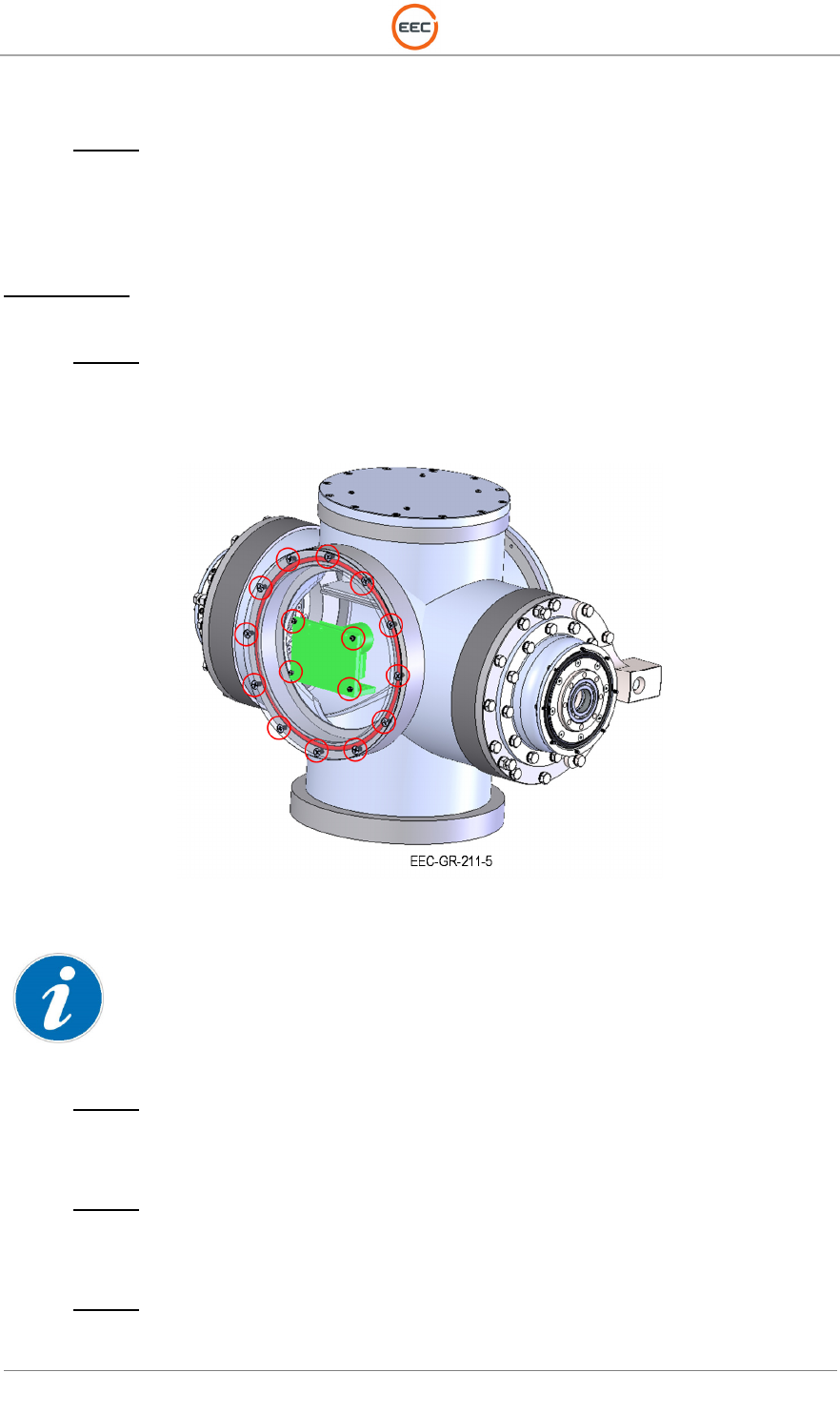
T
ECHNICAL
D
OCUMENTATION
P
ROTECTING
P
EOPLE AND
A
SSETS
®
D
ATE
:
22
M
ARCH
2017
|
V
ERSION
:
1.4
32
R
ANGER
-X5
R
ADAR
S
YSTEM
T
ROUBLESHOOTING
,
M
AINTENANCE
,
AND
C
ALIBRATION
EEC
®
|
C
OMPANY
P
ROPRIETARY
1. Step 1:
The Regeneration Clamp will prevent power from reaching the Servo Controller and the
Servo Amplifier. Check the input Voltage (V IN + and V IN -) to ensure input power is
available. If not, troubleshoot power through the Pedestal at Terminal Block 1 (TB1).
Maintenance:
1. Step 1:
Remove the Screws (12 Philips Screws) retaining the cover where the regeneration
clamp is mounted. (See Figure 10, red circles)
Figure 10. Regeneration Clamp
This will removed the cover where the Regeneration Clamp is mounted.
2. Step 2:
Remove the four (4) screws connecting the Regeneration Clamp to the cover.
3. Step 3:
Remove all cable connections.
4. Step 4:
Reinstall the Regeneration Clamp in reverse order of Steps 1-3.

T
ECHNICAL
D
OCUMENTATION
P
ROTECTING
P
EOPLE AND
A
SSETS
®
D
ATE
:
22
M
ARCH
2017
|
V
ERSION
:
1.4
33
R
ANGER
-X5
R
ADAR
S
YSTEM
T
ROUBLESHOOTING
,
M
AINTENANCE
,
AND
C
ALIBRATION
EEC
®
|
C
OMPANY
P
ROPRIETARY
Calibration:
None
2.1.3. Payload Support Assembly (Unit 2 A1 A3)
2.1.3.1. Plenum Assembly (Unit 2 A1 A3 A1)
2.1.3.1.1. IQ2 Intermediate Frequency Digitizer Assembly (Unit 2 A1 A3 A1 A1)
Troubleshooting:
SD-135953-101 or -101 Sheet 1 of 4 (Power)
Sheet 3 of 4 (Communication)
Sheet 4 of 4 (Trigger)
SD-133066-101 Sheet 1 of 1
1. Step 1 (Power):
The 24VDC Power supplied to the IQ2 PSU PCA routes from the Slip Ring Assembly to
Terminal Block 1 (TB1) in the Payload Support Assembly on Pins 7 and 8, and from there
to the IQ2 PSU PCA Plug (Pin 1 and 2). Use the appropriate Schematics to trace the
power from the source to the PSU in a logical manner. Is power present at the plug?
YES: Go to Step 2.
NO: Trace the power back to the power supply and restart this troubleshooting
procedure.
2. Step 2 (Power Supply Unit - PSU):
If 24VDC Power is available in Step 1 on the input side of the PSU, check the output side
of the 5VDC power at Pin 5 and 6 on the PSU. Is output power present?
YES: Go to Step 3.
NO: Replace the PSU and restart this troubleshooting procedure.
3. Step 3 (Communication):
Does the IQ2-IFD respond to commands via the Ethernet Connection?
YES: Go to Step 4.
NO: Troubleshoot the Ethernet Connection through:
• Ethernet Switch (Unit 2 A1 A3 A1 A5)
• Slip Ring (Unit 2 A1 A1 A1)
• Azimuth Assembly (Unit 2 A1 A1: SD-135887-100, Sheet 1 of 3)
• Pedestal Plate Enclosure Assembly (Unit 2 A1 A5: SD-135886-100, Sheet 3 of 3)
• Fiber Optic Media Converter (Unit 1 A8)
• 16-Port Gigabit Ethernet Switch (Unit 1 A5).
If the communication connection is restored, continue to Step 4.

T
ECHNICAL
D
OCUMENTATION
P
ROTECTING
P
EOPLE AND
A
SSETS
®
D
ATE
:
22
M
ARCH
2017
|
V
ERSION
:
1.4
34
R
ANGER
-X5
R
ADAR
S
YSTEM
T
ROUBLESHOOTING
,
M
AINTENANCE
,
AND
C
ALIBRATION
EEC
®
|
C
OMPANY
P
ROPRIETARY
4. Step 4 (Fiber Optic):
If the Ethernet Connection is working, but digitized data is not making it from the IQ2-IFD
to the IQ2-DSP via the Fiber Optic Connection, then check the Fiber Optic Cables and
Connectors. Check the following components / connections:
• IQ2-IFD Connector
• Fiber -Optic Cable from IQ2-IFD to the Fiber-Optic Slip Ring
• Fiber-Optic Slip Ring to the Fiber-Optic Interconnect in the Pedestal Plate
Enclosure (P3 on SD=135886-100, Sheet 3 of 3)
• Fiber-Optic Interconnect on the Pedestal Plate Enclosure to the Fiber-Optic
Interconnect in the Control Cabinet (P3 on SD-135732-100).
• From the Fiber-Optic Interconnect to the IQ2-DSP
Is the Fiber Optic Connection Restored?
YES: Go to Step 5.
NO: Replace the defective connection. If the problem is isolated to the Fiber-Optic Slip
Ring, contact Enterprise Electronics Corporation.
5. Step 5 (Data):
If power, communications, and the Fiber-Optic connections are all operational, the IQ2-
IFD is likely defective. Replace the IQ2-IFD.
Maintenance:
1. Step 1:
Remove the cover from the Plenum Assembly by releasing the four quick-disconnect
latches and by loosening two Retaining Screws (see Figure 11), then remove the lid.
Figure 11. Plenum Assembly – Cover Retaining Screws and Latches
1. Step 2:
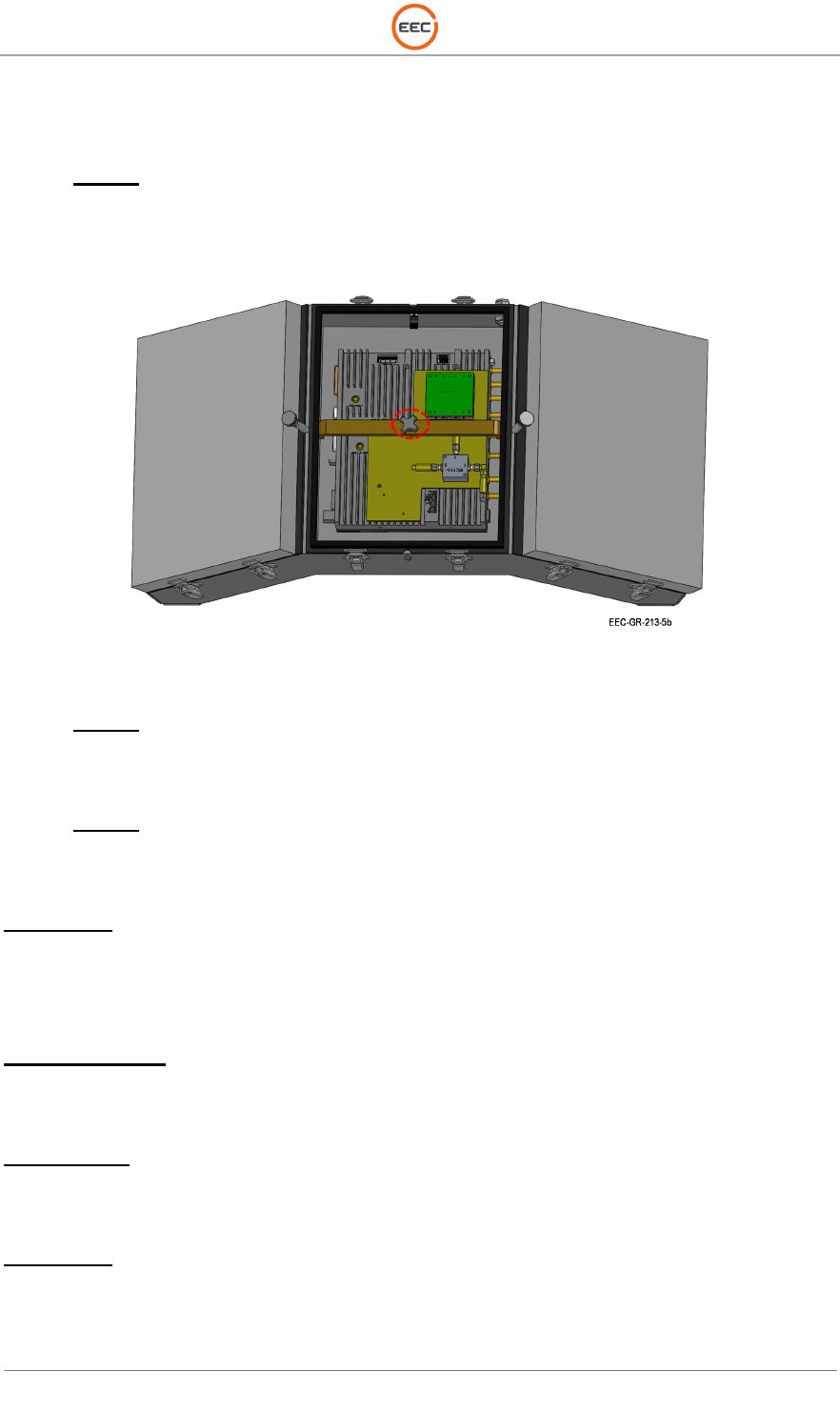
T
ECHNICAL
D
OCUMENTATION
P
ROTECTING
P
EOPLE AND
A
SSETS
®
D
ATE
:
22
M
ARCH
2017
|
V
ERSION
:
1.4
35
R
ANGER
-X5
R
ADAR
S
YSTEM
T
ROUBLESHOOTING
,
M
AINTENANCE
,
AND
C
ALIBRATION
EEC
®
|
C
OMPANY
P
ROPRIETARY
Disconnect all connectors and unplug the Ethernet cable and Fiber-Optic Cable.
2. Step 3:
Loosen and remove retaining bracket in the center of the IQ2-IFD holding IQ2-IFD in
place. See Figure 12
Figure 12. Plenum Assembly – IQ2-IFD Retaining Bracket
3. Step 4:
Remove the IQ2-IFD from the Plenum Assembly.
4. Step 5:
Reinstall in reverse order of Steps 1-4.
Calibration:
See Paragraph 5.4.1, 5.4.2, 5.4.3, and 5.4.4.
2.1.3.1.1.1. IQ2 IFD PCA (Unit 2 A1 A3 A1 A1 A1)
Troubleshooting:
Part of the IQ2-IFD Troubleshooting Process, see Paragraph 2.1.3.1.1.
Maintenance:
Part of the IQ2-IFD Maintenance Process, see Paragraph 2.1.3.1.1.
Calibration:
Part of the IQ2-IFD Calibration Process, see Paragraph 2.1.3.1.1.

T
ECHNICAL
D
OCUMENTATION
P
ROTECTING
P
EOPLE AND
A
SSETS
®
D
ATE
:
22
M
ARCH
2017
|
V
ERSION
:
1.4
36
R
ANGER
-X5
R
ADAR
S
YSTEM
T
ROUBLESHOOTING
,
M
AINTENANCE
,
AND
C
ALIBRATION
EEC
®
|
C
OMPANY
P
ROPRIETARY
2.1.3.1.1.2. 10dB Attenuator (Unit 2 A1 A3 A1 A1 AT1, AT2)
Troubleshooting:
Part of the IQ2-IFD Troubleshooting Process, see Paragraph 2.1.3.1.1.
Maintenance:
Part of the IQ2-IFD Maintenance Process, see Paragraph 2.1.3.1.1.
Calibration:
Part of the IQ2-IFD Calibration Process, see Paragraph 2.1.3.1.1.
2.1.3.1.1.3. IQ2 Power Supply Unit PCA (Unit 2 A1 A3 A1 A1 A2)
Troubleshooting:
SD-135953-100 or -101 Sheet 1 of 4
SD-134066-101 Sheet 1 of 1
SD-134862-100 Sheet 1 of 1
Part of the IQ2-IFD Troubleshooting Process, see Paragraph 2.1.3.1.1.
Maintenance:
Part of the IQ2-IFD Maintenance Process, see Paragraph 2.1.3.1.1.
Calibration:
Part of the IQ2-IFD Calibration Process, see Paragraph 2.1.3.1.1.
2.1.3.1.1.4. 2-Way Splitter (Unit 2 A1 A3 A1 A1 HY1)
Troubleshooting:
Part of the IQ2-IFD Troubleshooting Process, see Paragraph 2.1.3.1.1.
Maintenance:
Part of the IQ2-IFD Maintenance Process, see Paragraph 2.1.3.1.1.
Calibration:
Part of the IQ2-IFD Calibration Process, see Paragraph 2.1.3.1.1.
2.1.3.1.2. I/O Control Module (Unit 2 A1 A3 A1 A3)

T
ECHNICAL
D
OCUMENTATION
P
ROTECTING
P
EOPLE AND
A
SSETS
®
D
ATE
:
22
M
ARCH
2017
|
V
ERSION
:
1.4
37
R
ANGER
-X5
R
ADAR
S
YSTEM
T
ROUBLESHOOTING
,
M
AINTENANCE
,
AND
C
ALIBRATION
EEC
®
|
C
OMPANY
P
ROPRIETARY
Troubleshooting:
SD-135953-100 or -101 Sheet 3 of 4 (Communication)
Sheet 4 of 4 (Trigger)
Troubleshoot each individual component separately.
2.1.3.1.2.1. Ethernet 16-Channel Discrete I/O Module (Unit 2 A1 A3 A1 A3 A1)
Troubleshooting:
SD-135964-100 Sheet 1 of 1
SD-135953-100 or 101 Sheet 3 of 4
1. Step 1 (Power):
Using a voltmeter, measure the DC Voltage the Discrete I/O Module (+24VDC) at Pin
31 and Pin 32. Is power present?
YES: Continue to Step 2.
NO: Troubleshoot the 24VDC Power System.
2. Step 2 (Communication):
Is the Ethernet connection working properly? Check the connection to the Ethernet
Switch (See Paragraph 2.1.3.1.4).
YES: Continue to Step 3.
NO: Troubleshoot the Ethernet connection.
3. Step 3 (Status):
If the unit has power (Step 1) and Ethernet Connection (Step 2), troubleshoot each of
the individual channels and relays per the following table:
Terminal Block
Pin
Status
TB1
11
Aux Power Enable
16
Return / Ground
TB2
21
UDC Power Enable
26
Return / Ground
TB4
43
Trigger Enable (K1)
44
Trigger Enable (K2)
45
Aux Power Enable
42
UDC Power Enable
Table 1. Discrete (Digital) I/O Module
Are all connections intact?
YES: If the problem persists, contact the manufacturer (EEC).
NO: Restore the connections and revalidate the tests.

T
ECHNICAL
D
OCUMENTATION
P
ROTECTING
P
EOPLE AND
A
SSETS
®
D
ATE
:
22
M
ARCH
2017
|
V
ERSION
:
1.4
38
R
ANGER
-X5
R
ADAR
S
YSTEM
T
ROUBLESHOOTING
,
M
AINTENANCE
,
AND
C
ALIBRATION
EEC
®
|
C
OMPANY
P
ROPRIETARY
Maintenance:
1. Step 1:
Remove the cover from the Plenum Assembly by releasing the four quick-disconnect
latches and by loosening two Retaining Screws (see Figure 11), then remove the lid.
2. Step 2:
Disconnect all connectors and unplug the Ethernet cable.
3. Step 3:
Loosen and remove the two (2) Philips head screws holding the retaining bracket in
place.
4. Step 4:
Remove the Discrete I/O Unit from the Plenum Assembly.
5. Step 5:
Reinstall in reverse order of Steps 1-4.
Calibration:
None
2.1.3.1.2.2. Ethernet 12-Channel Analog I/O Module (Unit 2 A1 A3 A1 A3 A2)
Troubleshooting:
SD-135964-100 Sheet 1 of 1
SD-135953-100 or -101 Sheet 3 of 4
4. Step 1 (Power):
Using a voltmeter, measure the DC Voltage the Analog I/O Module (+24VDC) at Pin 31
and Pin 32. Is power present?
YES: Continue to Step 2.
NO: Troubleshoot the 24VDC Power System.
5. Step 2 (Communication):
Is the Ethernet connection working properly? Check the connection to the Ethernet
Switch (See Paragraph 2.1.3.1.4).
YES: Continue to Step 3.
NO: Troubleshoot the Ethernet connection.

T
ECHNICAL
D
OCUMENTATION
P
ROTECTING
P
EOPLE AND
A
SSETS
®
D
ATE
:
22
M
ARCH
2017
|
V
ERSION
:
1.4
39
R
ANGER
-X5
R
ADAR
S
YSTEM
T
ROUBLESHOOTING
,
M
AINTENANCE
,
AND
C
ALIBRATION
EEC
®
|
C
OMPANY
P
ROPRIETARY
6. Step 3 (Status):
If the unit has power (Step 1) and Ethernet Connection (Step 2), troubleshoot each of
the individual channels and relays per the following table:
Terminal Block
Pin
Status
TB1
11
H Transmitter +5V Monitor
12
H UDC +5V Monitor
13
Return / Ground
14
H Transmitter +12V Monitor
15
H +48V Current
16
Return / Ground
TB2
21
H Temp Sensor
22
H Humidity Sensor
23
Return / Ground
24
V Transmitter +5V Monitor
25
V UDC +5V Monitor
26
Return / Ground
TB4
41
V Transmitter +12V Monitor
42
V +48V Current
43
Return / Ground
44
V Temp
Sensor
45
V Humidity Sensor
46
Return / Ground
Table 2. Analog I/O Map
Are all connections intact?
YES: If the problem persists, contact the manufacturer (EEC).
NO: Restore the connections and revalidate the tests.
Maintenance:
1. Step 1:
Remove the cover from the Plenum Assembly by releasing the four quick-disconnect
latches and by loosening two Retaining Screws (see Figure 11), then remove the lid.
5. Step 2:
Disconnect all connectors and unplug the Ethernet cable.
6. Step 3:
Loosen and remove the two (2) Philips head screws holding the retaining bracket in
place..
7. Step 4:
Remove the Analog I/O Unit from the Plenum Assembly.

T
ECHNICAL
D
OCUMENTATION
P
ROTECTING
P
EOPLE AND
A
SSETS
®
D
ATE
:
22
M
ARCH
2017
|
V
ERSION
:
1.4
40
R
ANGER
-X5
R
ADAR
S
YSTEM
T
ROUBLESHOOTING
,
M
AINTENANCE
,
AND
C
ALIBRATION
EEC
®
|
C
OMPANY
P
ROPRIETARY
8. Step 5:
Reinstall in reverse order of Steps 1-4.
Calibration:
None
2.1.3.1.3. Cold Plate, Weatherized (Unit 2 A1 A3 A1 A4)
Troubleshooting:
EEC-135540-101 Sheet 1 of 3
Sheet 3 of 3
SD-135953-100 or -101 Sheet 1 of 4
1. Step 1 (Power):
Using a voltmeter, measure the DC Voltage at the Terminal Block (TB1) in the Plenum
Assembly (Pin 7 and 8) for the Cold Plate and (Pin 9 and 10) for the Temperature
Controller (Unit 2 A1 A3 A1 A6). It Power Present?
YES: Continue to Step 2.
NO: Troubleshoot the 24VDC Power System.
2. Step 2 (Power):
Using a voltmeter, measure the DC Voltage at the input for the Cold Plate and
Temperature Controller (Unit 2 A1 A3 A1 A6). It Power Present?
YES: Continue to Step 3.
NO: Troubleshoot the Temperature Controller (Unit 2 A1 A3 A1 A6).
3. Step 3 (Temperature Controller):
Check the output power on the Temperature Controller. It Power Present?
YES: Continue to Step 4.
NO: Replace the Temperature Controller (Unit 2 A1 A3 A1 A6) and continue
Troubleshooting.
4. Step 4 (Fan)
Is the Fan operating?
YES: Go to Step 5.
NO: Replace the fan.
5. Step 5 (Cold Plate)
Is the Cold Plate operating?
YES: End process.